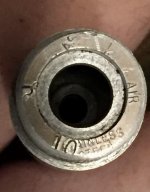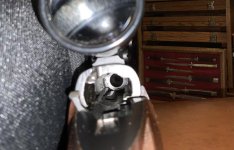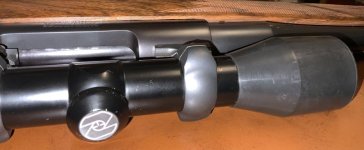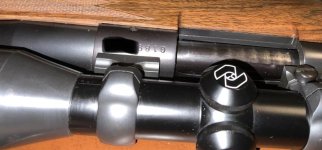You are using an out of date browser. It may not display this or other websites correctly.
You should upgrade or use an alternative browser.
You should upgrade or use an alternative browser.
Not Your Typical Push-Feed Winchester Model 70!
- Thread starter s&wchad
- Start date
For the life of me I don't understand what some people are thinking! This sat on a show table for several hours priced at $650 and no one snatched it up. The "expert" seller had it tagged as a standard factory gun and accepted my offer of $550. I would have paid more than the asking price!
....
Usually when I see a tag like that, I take a closer look and there's actually a "1" between the dollar sign and the other numbers.
Ivan the Butcher
Member
It's chambered in .284 Winchester and came with a Burris 3-9X scope, about 60 rounds of ammo, lot of brass and dies.About 15 years ago I acquired a customized Rem 700 in 6x284 with dies a about 250 virgin Winchester brand brass. As I formed brass I also formed 10 each from 6.5x284 Norma & Lapua Brass. As load development progresses, I wanted to know which brass performed the best. I loaded 10 of each brass with the same tray of primers, box of bullets and can of powder. In the same est of dies, I couldn't make these 30 rounds of ammo any more identical!
Test results: At 100 yards the Norma Brass shot a 3/8" group, the Lapua Brass shot a 3/8" group, and the Winchester Brass shot a 1 1/8" group!
I ended giving the Winchester brass to a Friend with a Model 88, and ordered mor Lapua Brass! The first Match I shot it in was a "One Shot" shoot at an unknown distance. I set my trajectory for 500 yards (I knew the range couldn't be much longer). The first target was a 2 liter bottle of orange soda. I could feel a slight breeze on my right cheek, so I placed the crosshair on the right edge of the bottle half way up, and fired. HIT! Half way up and 1" off the right edge. Second Target was a 16 ounce bottle of Coke, Aimed dead center. HIT. I was the only person to hit the second target. I won the pot. $53 winnings.
Turns out after the shoot I laser ranged the target: 527 yards. There was a nearby poster, I fired a 5 shot group on it, slightly less than an inch. (less than .2 MOA)
A two time national champion rifle shooter (and member of the original Army Marksmanship Unit.) told me something I always consider: You CANNOT have good ammunition without good brass!
The guy that had the gun build was into Extreme Velocity and had it built with a slow twist barrel, 1:12. I'm into Extreme Distance and would have gone with 1:7. But there is no denying it is a good gun. I used IMR 4831SC, Federal 210M primer, and Sierra Blitzking 70 grain bullet, a varmint bullet not a Match bullet. It performed better than Hornady, Nosler or Berger bullets in the same weight range.
Ivan
BTW, the scope I use on this gun Is an old Burris 8x32 target scope with more adjustment than an aircraft carrier and about 2 feet long! Single fine crosshair.
Last edited:
Wow!
Great find!
The stock probably cost over $2K to make and it's chambered for such a cool round.
It's finds like that, that make gun shows a worthwhile adventure.
Great find!
The stock probably cost over $2K to make and it's chambered for such a cool round.
It's finds like that, that make gun shows a worthwhile adventure.
What a doggy 'ol Winchester. Tell you what, I'll take it off your hands and get you your money back, just 'cause I'm a nice guy��
Seriously though-Beautiful rifle. That stock alone should bring what you paid for the complete rig. You made out big time��(I will give you your money back though if you're interested��
Seriously though-Beautiful rifle. That stock alone should bring what you paid for the complete rig. You made out big time��(I will give you your money back though if you're interested��
Nicely done. You bought a REAL RIFLE at a bargain price!
ColbyBruce
Member
Beautiful rifle. Gret find.
Custom builds on the secondary market can be great values. Even better when the seller doesn't know what they have.
The 'smith may have marked/signed their work in the inletting.
They usually like to take credit even if discreetly.
Custom builds on the secondary market can be great values. Even better when the seller doesn't know what they have.
The 'smith may have marked/signed their work in the inletting.
They usually like to take credit even if discreetly.
That's an amazing deal for a fine rifle like that- nice score (and in a great old cartridge).
I looked at the chamber end and didn't see any markings. This is the best photo I could get...The few Douglas barrels I have owned had the info stamped around the chamber end of the barrel, like in the photo.
As I mentioned before, I'm reluctant to pull the action because of the tight inletting. The barrel is free-floated and it may be glass bedded.
It closely matches the contours of a Douglas Light Sporter, but it could also be a Shaw or Shilen. I'm sure it's not a Winchester OEM barrel.
It measures .590" at the muzzle, but is only 18-1/2" long.
Attachments
The bbl is 'glass' bedded from the breech end forward at least the length of the chamber area of the bbl.
You can see the thin sliver of bedding material on either side.
That's a common area to bed along with the recv'r ring and the recoil lug.
The rear tang is likely glass bedded as well. The two areas are generally done together.
The socket head action screws make it easier to disassemble w/o the chance of marring anything. But unless the need to look inside is so overwhelming that you just can't stand it, there's probably no good reason to tear it down to look.
Great wood and checkering.
The ribbon pattern checkering of that quality is the price of the rifle or more these days.
A nice combination of Point Pattern and Fill-In pattern style with it's smooth french curve borders.
Note that the grip checkering goes 'over the top' of the grip in one piece. That's not something checkering people do inexpensively and it's difficult to do.
The lines pointing 'upwards' on one side have to become the checkering lines in the pattern pointing 'downwards' on the opposite side of the stock.
That change in direction occurs at the exact center line of the grip on top. There has to be no change in diamond shape or LPI on the sharply curved surface to make it look right. Not easy, so not often done.
Many Over-the-Top grip patterns cheat and have a small border line there on the CL of the grip where the two side patterns meet.
Not at all bad looking, but not the same as a true OTT checkering layout pattern.
Small things that make a big difference when comparing Custom work. Small things that would have made a big difference in the bill for the work if the gun was built for a specific customer too.
Many of these orphaned custom pieces found for sale were made on speculation. Meaning they were built by the 'smith not for a specific customer, but for display and for sale at the same time.
So the gun often has quite a lot more time into it than the price they end up getting for it.
You can see the thin sliver of bedding material on either side.
That's a common area to bed along with the recv'r ring and the recoil lug.
The rear tang is likely glass bedded as well. The two areas are generally done together.
The socket head action screws make it easier to disassemble w/o the chance of marring anything. But unless the need to look inside is so overwhelming that you just can't stand it, there's probably no good reason to tear it down to look.
Great wood and checkering.
The ribbon pattern checkering of that quality is the price of the rifle or more these days.
A nice combination of Point Pattern and Fill-In pattern style with it's smooth french curve borders.
Note that the grip checkering goes 'over the top' of the grip in one piece. That's not something checkering people do inexpensively and it's difficult to do.
The lines pointing 'upwards' on one side have to become the checkering lines in the pattern pointing 'downwards' on the opposite side of the stock.
That change in direction occurs at the exact center line of the grip on top. There has to be no change in diamond shape or LPI on the sharply curved surface to make it look right. Not easy, so not often done.
Many Over-the-Top grip patterns cheat and have a small border line there on the CL of the grip where the two side patterns meet.
Not at all bad looking, but not the same as a true OTT checkering layout pattern.
Small things that make a big difference when comparing Custom work. Small things that would have made a big difference in the bill for the work if the gun was built for a specific customer too.
Many of these orphaned custom pieces found for sale were made on speculation. Meaning they were built by the 'smith not for a specific customer, but for display and for sale at the same time.
So the gun often has quite a lot more time into it than the price they end up getting for it.
Last edited:
The 7mm-284 is known for long range accuracy. I'm betting the original owner had it built for a specific hunt, and afterwards had no further use for it. I would have a hard time parting with it just because it is such a beautifully built rifle. I'd bet when built that rifle was easily in the $1500+ range.
The original owner was deceased and had no say in the sale, but it may have caused him to roll over in his grave. I bought it from an "expert" selected by the family to liquidate his guns.I'm betting the original owner had it built for a specific hunt, and afterwards had no further use for it. I would have a hard time parting with it just because it is such a beautifully built rifle.
Mine in 270
Never having shot a pre-'64 Winchester, I really do not understand why so many people cannot abide the post '64 push-feed action, but I am glad of it as a buyer. That prejudice depressed prices, allowing me to get my 1983(?) Model 70, Featherweight XTR, chambered in .270WIN, at a pawn shop in Kennesaw Georgia for a little over $300. In 1990, that was a serious purchase for me.
I've been told that push feed rifles in the seventies era had poor quality control and ugly stocks. The XTR's continued to be very nice rifles though right up until they brought out the "classic" CRF in 1992. There is no conceivable scenario wherein I will ever be smart enough or physically capable and skilled enough to shoot a better rifle. I have been through several scopes. The Leupold on it now is the last one it will have during my life. I will not sell the rifle at any price.
It is so much fun to rapid fire a bolt action. See the technique on YouTube demonstrated by Gen Scinmore called "ultra rapid fire". It is impossible if you short stroke the bolt. It is expensive to practice.
No human will ever pay what it is worth to me. When I die my heirs will sell it for maybe $650. The inflation calculator tells me the same deal I got would be $900+ today. My opinion about the seller of your rifle, is that his expertise included knowledge of this phenomenon. The chance of finding a buyer with the level of sense that you have, your level of knowledge and appreciation of quality (who also wants to buy a rifle) is vanishingly small.
Another important truth should be considered, which I have learned or at least seen confirmed by many on our wonderful forum is that you will never get your money back for upgrades on your firearm, but don't let that stop you. The previous owner did good things to this rifle. I will be looking forward to a range report about it from you. Congratulations on a great find.
The original owner was deceased and had no say in the sale, but it may have caused him to roll over in his grave. I bought it from an "expert" selected by the family to liquidate his guns.
Never having shot a pre-'64 Winchester, I really do not understand why so many people cannot abide the post '64 push-feed action, but I am glad of it as a buyer. That prejudice depressed prices, allowing me to get my 1983(?) Model 70, Featherweight XTR, chambered in .270WIN, at a pawn shop in Kennesaw Georgia for a little over $300. In 1990, that was a serious purchase for me.
I've been told that push feed rifles in the seventies era had poor quality control and ugly stocks. The XTR's continued to be very nice rifles though right up until they brought out the "classic" CRF in 1992. There is no conceivable scenario wherein I will ever be smart enough or physically capable and skilled enough to shoot a better rifle. I have been through several scopes. The Leupold on it now is the last one it will have during my life. I will not sell the rifle at any price.
It is so much fun to rapid fire a bolt action. See the technique on YouTube demonstrated by Gen Scinmore called "ultra rapid fire". It is impossible if you short stroke the bolt. It is expensive to practice.
No human will ever pay what it is worth to me. When I die my heirs will sell it for maybe $650. The inflation calculator tells me the same deal I got would be $900+ today. My opinion about the seller of your rifle, is that his expertise included knowledge of this phenomenon. The chance of finding a buyer with the level of sense that you have, your level of knowledge and appreciation of quality (who also wants to buy a rifle) is vanishingly small.
Another important truth should be considered, which I have learned or at least seen confirmed by many on our wonderful forum is that you will never get your money back for upgrades on your firearm, but don't let that stop you. The previous owner did good things to this rifle. I will be looking forward to a range report about it from you. Congratulations on a great find.
handejector
Staff member
- Joined
- Mar 17, 2005
- Messages
- 26,134
- Reaction score
- 47,040
The dealer obviously did not know that he should sell popcorn to attract the more savvy buyers. 
MIGHT be signed or marked in the barrel channel.
Superb work. Jack O'Connor would be proud of ya!
MIGHT be signed or marked in the barrel channel.
Superb work. Jack O'Connor would be proud of ya!
Just for the record, the post '64 model 70 did have an almost branding iron like checkering and a free float barrel which was quite a departure form the original. It also fully encased the shell in the bolt which made it stronger. The new rifles did not look as elegant but were every bit as accurate if not more so. I will say however that the aluminum magazine cover was not and improvement over the previous steel. Winchester did have to cut costs and it did not go well with the rifle community. They also cut the fine model 12 shotguns and came out with the 1200-1400 series which did not go well for them. My brother was a die hard model 70 fan and bought a new 1964 model in 270. It was a real tack driver.
Walter Rego
Member
That's a beautiful rifle. Is it built on the long or short action ? I have read that the .284 cartridge was originally designed around a short action and that somewhat hampered the performance but you could seat the bullet out a little more in a long action and increase the powder capacity a few grains.
That's a beautiful rifle. Is it built on the long or short action ? I have read that the .284 cartridge was originally designed around a short action and that somewhat hampered the performance but you could seat the bullet out a little more in a long action and increase the powder capacity a few grains.
It's a short action. The cartridge was originally designed to offer .270 Win performance is the Winchester models 88 and 100. I haven't checked the chamber yet and don't know the twist or the free-bore. I doubt loading from the magazine is an issue and ejection has nothing to do with the seating depth. Modern powders probably negate the case capicity.
Last edited:
- Joined
- Feb 9, 2006
- Messages
- 3,565
- Reaction score
- 6,324
That is flat out beautiful. Gotta love it when the experts are wrong.
I just noticed that the bolt body, generally machined turned in the "white," appears to have been blued. A nice touch.
It has been my fortune to own and shoot several pre and post 64' Mod. 70 rifles. They have all been extremely accurate and 100% reliable.
One of my post 64" rifles was transformed into a 1,000 yard gun for NRA high-power competition. It was chambered in 6.5 x .284 and shot like a house afire! That rifle helped me win our state 1K yard championship a few years back.
Beautiful rifle in a great caliber!
It has been my fortune to own and shoot several pre and post 64' Mod. 70 rifles. They have all been extremely accurate and 100% reliable.
One of my post 64" rifles was transformed into a 1,000 yard gun for NRA high-power competition. It was chambered in 6.5 x .284 and shot like a house afire! That rifle helped me win our state 1K yard championship a few years back.
Beautiful rifle in a great caliber!
Last edited:
Similar threads
- Locked
Expired/Withdrawn
Firearms for Sale S&W, Marlin, Browning, Winchesters
- Replies
- 0
- Views
- 952
- Replies
- 3
- Views
- 2K
- Replies
- 33
- Views
- 3K
- Replies
- 35
- Views
- 22K






